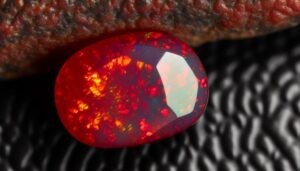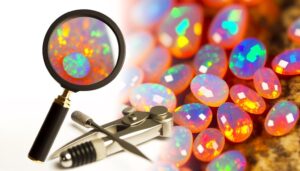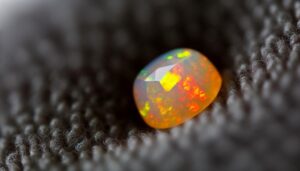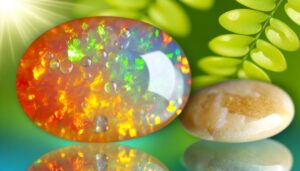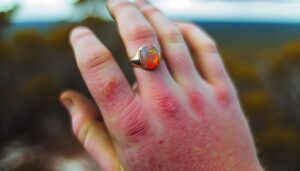How Are Mexican Fire Opals Enhanced?
Yes, Mexican Fire Opals can be enhanced to improve their appearance and durability. Methods include resin or oil impregnation to fill cracks, heat treatments to boost color and clarity, and dyeing to intensify or alter hues.
Surface coatings can also add protection. These enhancements often require professional handling to avoid damage and aren't always detectable without specialized equipment.
Understanding these techniques helps you assess authenticity and value. There's much more to contemplate about how these enhancements impact value and the ethical implications.
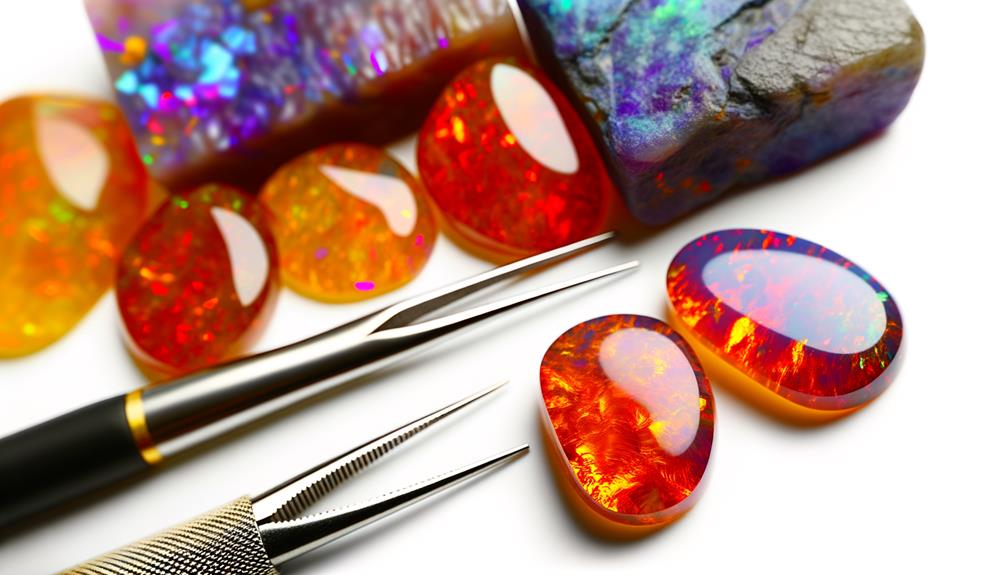
Key Takeaways
- Mexican Fire Opals can be enhanced through heat treatment to improve color and clarity.
- Resin infusion is a common enhancement to increase durability and luster of Mexican Fire Opals.
- Dyeing techniques are used to intensify or alter the color of Mexican Fire Opals.
- Surface coatings can be applied to protect Mexican Fire Opals and enhance their appearance.
- Enhancements are often undetectable without specialized equipment, making inquiries about treatments essential for authenticity.
Natural Characteristics
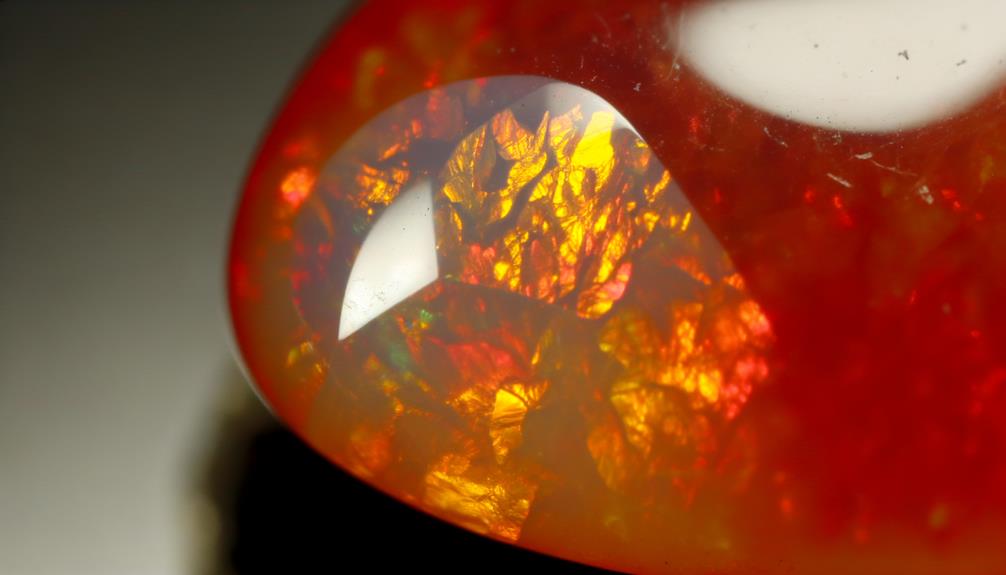
Mexican fire opals display a vibrant play of color, ranging from warm reds and oranges to bright yellows, due to the presence of iron oxide within their structure.
You'll notice that these opals are uniquely transparent to translucent, setting them apart from other opal varieties. They usually form in rhyolitic volcanic rock, which contributes to their unique characteristics.
Unlike other opals, Mexican fire opals often lack the internal 'play-of-color' seen in precious opals but compensate with their striking body color.
When evaluating these gems, you'll find their hardness ranges from 5.5 to 6.5 on the Mohs scale, indicating moderate durability. Their refractive index falls between 1.37 and 1.47, which impacts their brilliance and luster.
Common Treatments
While appreciating the natural beauty of fire opals, it's important to recognize the common treatments applied to enhance their appearance and durability.
One prevalent method is impregnation, where resin or oil is introduced into the stone to fill cracks and improve structural integrity. This process enhances the opal's luster and overall visual appeal.
Another treatment involves dyeing, which can intensify or alter the stone's color. Such procedures are often undetectable without specialized equipment.
Additionally, surface coatings with clear substances can protect the opal from scratches and environmental damage.
When purchasing fire opals, always inquire about these treatments to make an informed decision regarding the stone's authenticity and value.
Understanding these treatments empowers you to appreciate fire opals responsibly.
Heat Treatment Process

Heat treatment, a vital and controlled process, modifies the internal structure of fire opals to enhance their color and clarity. You'll need to carefully regulate temperatures, often between 300°C and 500°C, to avoid damaging the opal's delicate structure.
This treatment can intensify the play-of-color and improve transparency by reducing the water content within the opal. It's important to monitor the duration and cooling rate, as rapid changes can cause cracking. The result is a more vibrant and visually appealing gemstone.
However, be aware that not all fire opals respond well to heat treatment, and improper handling can lead to irreparable damage. Always make sure you're working with a professional who understands the intricacies of this process.
Resin Infusion
You'll find that resin infusion enhances Mexican fire opals by improving their durability and appearance.
The process involves cleaning the opal, immersing it in resin, and curing it under controlled conditions.
This method not only strengthens the gemstone but also enhances its color and clarity.
Purpose of Infusion
Resin infusion primarily aims to enhance the durability and visual appeal of Mexican fire opals by stabilizing the gem's structure and intensifying its natural colors.
You'll find that this process addresses inherent vulnerabilities in the opal's composition, such as porosity and fractures.
By introducing resin, the gem's structural integrity is greatly improved, reducing the risk of cracking and chipping. Additionally, the infusion process amplifies the opal's vibrant play-of-color, making it more visually engaging.
This enhancement not only boosts the gem's aesthetic value but also ensures it withstands everyday wear.
Consequently, resin infusion is a favored method for transforming Mexican fire opals into more durable and visually alluring gemstones, suitable for various jewelry applications.
Infusion Process Steps
To achieve the enhanced durability and visual appeal of Mexican fire opals through resin infusion, you'll need to follow a meticulous series of steps. First, clean the opal to remove any debris. Then, prepare the resin mixture according to the manufacturer's instructions. Next, place the opal in a vacuum chamber to eliminate air bubbles. Infuse the resin into the opal under vacuum, ensuring complete saturation. Finally, cure the resin-infused opal under UV light or heat as specified.
| Step | Description | Tools Required |
|---|---|---|
| Cleaning | Remove debris from the opal | Soft brush, water |
| Mixing | Prepare resin mixture | Resin kit, stirrer |
| Vacuuming | Eliminate air bubbles | Vacuum chamber |
| Infusion | Saturate opal with resin | Vacuum chamber, resin |
| Curing | Harden the resin | UV light or heater |
Benefits of Resin
By using resin infusion, you greatly enhance the structural integrity and visual brilliance of Mexican fire opals. Resin fills microfractures and voids, making the opal more durable and less prone to chipping or breaking.
It also amplifies the stone's natural play-of-color, giving it a more vivid and captivating appearance. The process involves using a vacuum chamber to ensure the resin penetrates deeply, hence achieving uniform enhancement.
This method not only improves the aesthetic quality but also extends the gemstone's lifespan. You'll find that resin-infused fire opals maintain their luster and resist environmental damage better than untreated stones.
Ultimately, resin infusion offers both practical and visual benefits, making it a preferred choice for gem enhancement.
Dyeing Techniques

When you're exploring dyeing techniques for Mexican fire opals, you'll encounter several common methods.
These include immersion dyeing and surface staining, each altering the gem's visual properties.
However, it's important to evaluate how these techniques affect the opal's durability and long-term stability.
Common Dye Methods
Gemologists employ various dyeing techniques to enhance the vibrant colors of Mexican fire opals, ensuring they meet market demands and aesthetic preferences.
One common method involves immersing the opal in a dye solution under controlled heat and pressure. This allows the dye to penetrate the stone's microstructure, resulting in intensified hues.
Another technique uses vacuum dyeing, where the opal is placed in a vacuum chamber with the dye, enabling deeper absorption.
Additionally, surface dyeing applies color only to the stone's exterior, creating a superficial enhancement.
Each method requires careful application to maintain the opal's natural beauty while achieving the desired color enhancement. Understanding these methods helps you appreciate the expertise involved in enhancing Mexican fire opals.
Effects on Durability
While enhancing the vibrant colors of Mexican fire opals through dyeing techniques, it's important to take into account how these methods affect the stone's overall durability.
Dyeing can introduce chemicals that may weaken the opal's structure, making it more susceptible to cracks and breakage. Additionally, the dye can fill the microscopic pores of the opal, altering its natural water content and potentially leading to dehydration and crazing over time.
You should be aware that dyed opals might require special care to maintain their appearance and structural integrity. Avoid exposing them to harsh chemicals, extreme temperatures, or prolonged water immersion, as these conditions could exacerbate any inherent weaknesses resulting from the dyeing process.
Implications for Value
The enhancement of Mexican fire opals greatly affects their market value, often increasing their appeal to collectors and investors. When considering the implications for value, you should note:
- Color Intensity: Enhanced fire opals can exhibit more vivid colors, which can notably boost their market price.
- Clarity Improvement: Treatments can reduce inclusions and enhance transparency, making the opal more desirable and expensive.
- Stability: Enhanced opals might offer better structural integrity, appealing to buyers looking for durable gemstones.
These factors collectively elevate the perceived worth of the opal, influencing both retail and resale prices. Understanding these enhancements helps you make informed decisions, whether you're buying, selling, or investing in Mexican fire opals.
Care and Maintenance
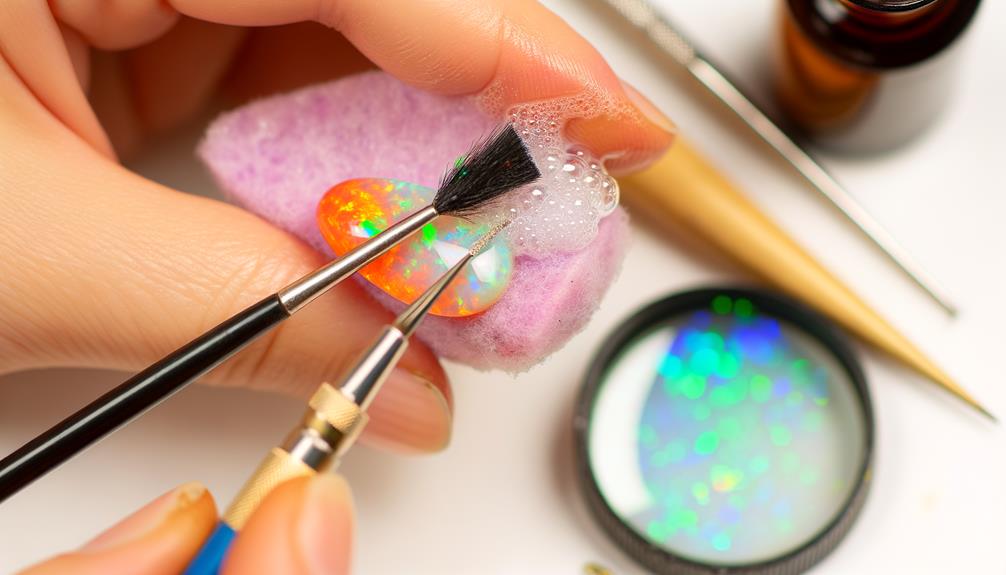
To preserve the enhanced beauty and structural integrity of Mexican fire opals, you must follow specific care and maintenance guidelines. Avoid exposing the opals to extreme temperature changes, as they can cause cracking.
Store them in a padded jewelry box to prevent scratches. Clean the opals using lukewarm water and a soft cloth; steer clear of harsh chemicals and ultrasonic cleaners.
Make sure to periodically check the settings if the opal is set in jewelry, ensuring it stays secure. Additionally, avoid prolonged exposure to direct sunlight, which can fade the opal's color.
Ethical Considerations
Considering the ethical implications of Mexican fire opal enhancement involves evaluating the environmental impact and labor practices associated with their production. You should be aware of the following key points:
- Environmental Impact:
The mining and enhancement processes can cause significant ecological disruption, affecting local water sources and soil quality.
- Labor Practices:
It's essential to make sure that workers involved in mining and enhancing these opals are treated fairly, paid adequately, and work in safe conditions.
- Transparency:
Be cautious of suppliers who don't disclose their methods and sources, as this lack of transparency often conceals unethical practices.
Conclusion
You've learned that Mexican fire opals can indeed be improved through various methods like heat treatment, resin infusion, and dyeing. These techniques can impact both the gem's value and care needs.
It's vital to ponder ethical implications when purchasing treated stones. Remember, buying an improved gem without full disclosure is as outdated as using a rotary phone.
Always seek transparency to guarantee you're making an informed decision.


